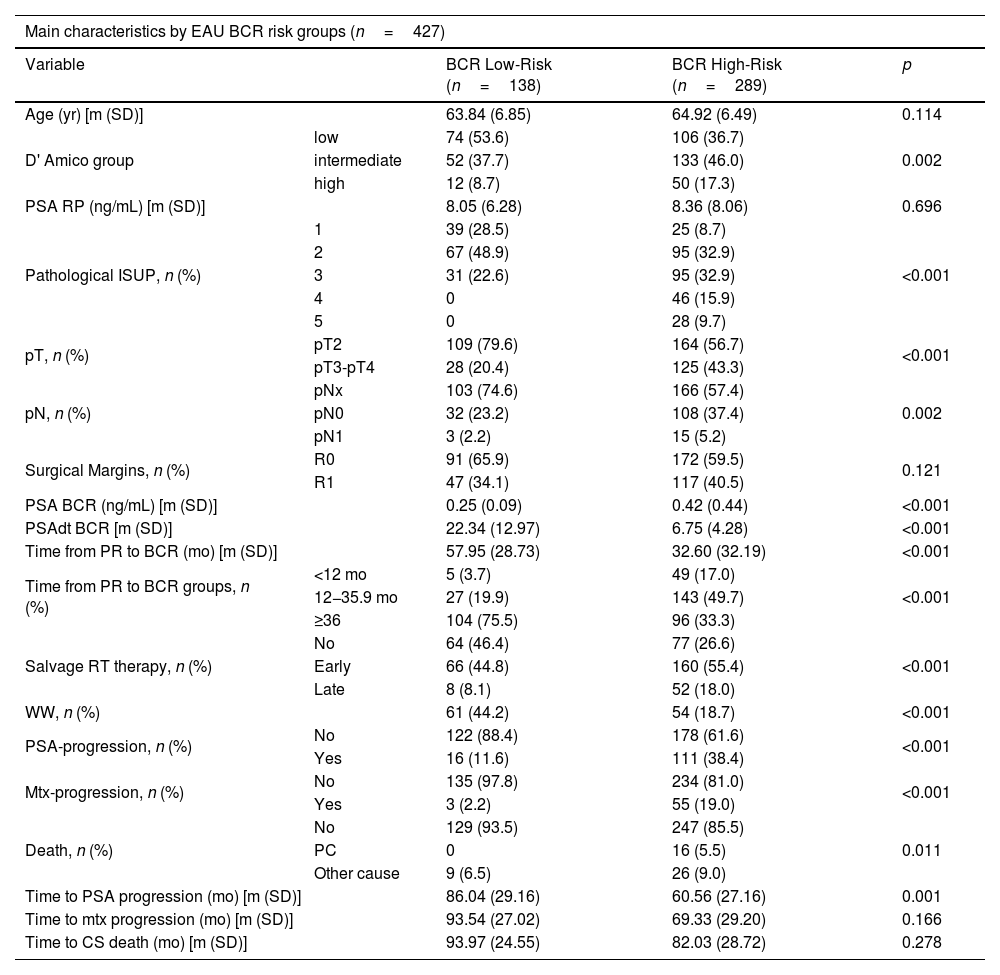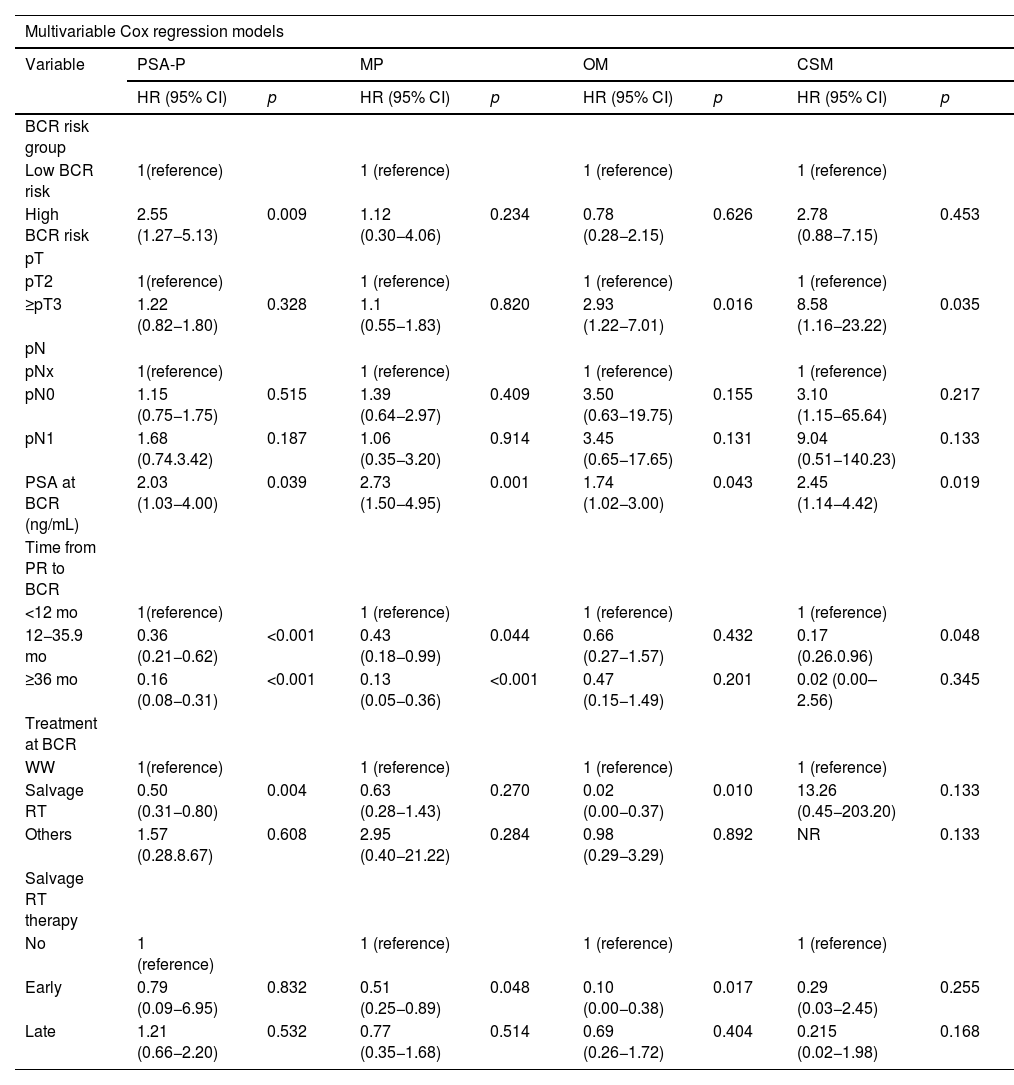The EAU proposed a progression and death risk classification in patients with biochemical recurrence after radical prostatectomy (PR).
ObjectiveTo validate the EAU BCR-risk classification in our setting and to find factors related to progression and death.
Material and methodsMulticenter, retrospective, observational study including 2140 patients underwent RP between 2011 and 2015. Patients with BCR were identified and stratified in low risk (PSA-DT >1yr and pGS <8) or high-risk (PSA-DT ≤1yr or pGS ≥8) grouping. PSA and metastatic free survival (PSA-PFS, MFS), cancer specific survival (CSS) and overall survival (OS) were calculated (Kaplan Meier curves and log-rank test). Independent risk factors were identified (Cox regression).
Results427 patients experienced BCR (32.3% low-risk and 67.7% high-risk). Median PSA-PFS was 135,0 mo (95% CI 129,63-140,94) and 115,0 mo (95% CI 104,02-125,98) (p<0,001), for low and high-risk groups, respectively. There were also significant differences in MFS and OS. The EAU BCR risk grouping was independent factor for PSA-progression (HR 2.55, p 0.009). Time from PR to BCR, was an independent factor for metastasis onset (HR 0.43, 95% CI 0.18−0.99; p 0.044) and death (HR 0.17, 95% CI 0.26.0.96; 23 p 0.048). Differences in MFS (p 0.001) and CSS (p 0.004) were found for <12, ≥12–<36 and ≥36 months from PR to BCR. Others independent factors were early salvage radiotherapy and PSA at BCR.
ConclusionsHigh-risk group is a prognostic factor for biochemical progression, but it has a limited accuracy on MP and death in our setting. The inclusion of other factors could increase its predictive power.
La EAU propuso una clasificación del riesgo de progresión y muerte en pacientes con recidiva bioquímica tras prostatectomía radical (PR).
ObjetivoValidar la clasificación de riesgo de RB de la EAU en nuestro contexto e identificar los factores asociados con la progresión y la muerte.
Material y métodosEstudio multicéntrico, retrospectivo y observacional que incluyó a 2140 pacientes sometidos a PR entre 2011 y 2015. Los pacientes con RB fueron identificados y estratificados en grupos de riesgo bajo (TD-PSA >1 año y pGS <8) o alto (TD-PSA <=1 año o pGS=>8). Se calcularon el PSA y la supervivencia libre de metástasis (SLP-PSA, SLM), la supervivencia cáncer específica (SCE) y la supervivencia global (SG) (curvas de Kaplan Meier y log-rank test). Se identificaron factores de riesgo independientes (regresión de Cox).
ResultadosUn total de 427 pacientes experimentaron RB (32,3% de bajo riesgo y 67,7% de alto riesgo). La mediana de SLP-PSA fue de 135,0 m (IC 95% 129,63-140,94) y 115,0 m (IC 95% 104,02-125,98) (p<0,001) para los grupos de bajo y alto riesgo, respectivamente. Hubo diferencias significativas en la SLM y la SG. El grupo de riesgo de RB de la EAU fue un factor independiente de progresión del PSA (HR 2,55; p 0,009). El tiempo transcurrido entre la PR y la RB fue un factor independiente de aparición de metástasis (HR 0,43; IC 95%: 0,18-0,99; p 0,044) y muerte (HR 0,17; IC 95%: 0,26-0,96; 23 p 0,048). Se hallaron diferencias en la SLM (p 0,001) y la SCE (p 0,004) para <12, ≥ 12-<36 y ≥36 meses transcurridos entre la PR y la RB. Otros factores independientes fueron la radioterapia de rescate precoz y el PSA en el momento de aparición de la RB.
ConclusionesEl grupo de riesgo alto es un factor pronóstico de progresión bioquímica, pero tiene una precisión limitada sobre la PM y la muerte en nuestro entorno. La inclusión de otros factores podría aumentar su poder predictivo.










